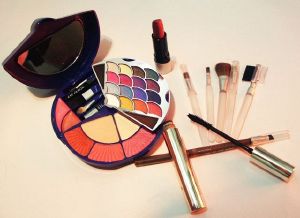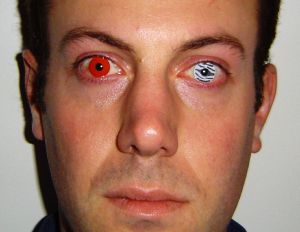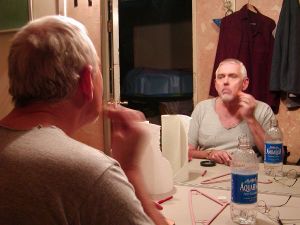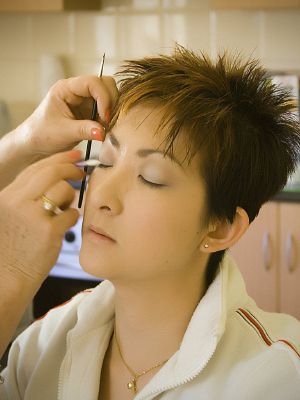Cosmetics
- "Make-up" redirects here.
- For other uses of the term, see Cosmetic.
Cosmetics (pronunciation: cosmetic ▶) are substances used to enhance or protect the appearance or odor of the human body. Cosmetics include skin-care creams, lotions, powders, perfumes, lipsticks, fingernail and toenail polishes, eye and facial makeup, permanent waves, hair colors, hair sprays and gels, deodorants, baby products, bath oils, bubble baths, bath salts, butters and many other types of products. Their use is widespread, especially among women in Western countries. A subset of cosmetics is called "make-up," which refers primarily to colored products intended to alter the user’s appearance. The manufacture of cosmetics is currently dominated by a small number of multinational corporations that originated in the early 20th century, but the distribution and sale of cosmetics is spread among a wide range of different businesses. The U.S. FDA which regulates cosmetics in the United States[1] defines cosmetics as: "intended to be applied to the human body for cleansing, beautifying, promoting attractiveness, or altering the appearance without affecting the body's structure or functions." This broad definition includes, as well, any material intended for use as a component of a cosmetic product. The FDA specifically excludes soap from this particular category.[2]
History

The first archaeological evidence of cosmetics usage is found in Ancient Egypt around 4000 B.C.E. The Ancient Greeks and Romans also used cosmetics. The Romans and Ancient Egyptians used cosmetics containing mercury and often lead.[3] The Biblical book of Esther describes various beauty treatments.
In the western world, the advent of cosmetics was in the middle ages, although typically restricted to use within the upper classes.
Cosmetic use was frowned upon at some points in history. For example, in the 1800s, make-up was used primarily by prostitutes, and Queen Victoria publicly declared makeup improper, vulgar, and acceptable for use by actors, only.[3] Adolf Hitler told women that face painting was for clowns and not for the women of the Master Race.
By the middle of the 20th century, cosmetics were in widespread use in nearly all societies around the world.
Industry Today
The worldwide annual expenditures for cosmetics is estimated at U.S. $18 billion.[4] Of the major firms, the oldest and the largest is L'Oréal, which was founded by Eugene Schueller in 1909 as the French Harmless Hair Colouring Company (now owned by Liliane Bettencourt 27.5% and Nestlé 26.4%, with the remaining 46.1% are publicly traded). The market was developed in the USA during the 1910s by Elizabeth Arden, Helena Rubinstein, and Max Factor. These firms were joined by Revlon just before World War II and Estée Lauder just after.
Criticism and controversy
The popularity of cosmetics in the 20th century has increased rapidly. Especially in the United States, cosmetics are being used by girls at a younger and younger age. Many companies have catered to this expanding market by introducing more flavored lipsticks and glosses, cosmetics packaged in glittery, sparkly packaging and marketing and advertising using young models. The social consequences of younger and younger beautification has had much attention in the media over the last few years.
Criticism of cosmetics has come from a variety of sources, including feminists, animal rights activists, books, and public interest groups. There is a growing awareness and preference for cosmetics that are without any toxic ingredients, especially those derived from petroleum, SLS, and parabens.[5]
Numerous published reports have raised concern over the safety of a few surfactants. SLS causes a number of skin issues including dermatitis.[6][7][8][9][10]
Parabens can cause skin irritation and contact dermatitis in individuals with paraben allergies, a small percentage of the general population.[11] Animal experiments have shown that parabens have a weak estrogenic activity, acting as xenoestrogens.[12]
Synthetic fragrances are widely used in consumers products. Studies concluded from patch testing, show synthetic fragrances are made of many allergic reaction ingredients.[13]
, Environmental Working Group, Campaign for Safe Cosmetics, and California Safe Cosmetics Act of 2005.
Types
The various forms of makeup include:
- Lipstick, lip gloss, lip liner, lip plumper, lip balm, lip luster, lip conditioner and lip boosters.[1]
- Foundation, used to color the face and conceal flaws to produce an impression of health and youth. Usually a liquid, cream, powder or mousse.[1]
- Powder, or face illuminator used to set the foundation, giving a matte finish.
- Rouge, blush or blusher, cheek stain used to color the cheeks and emphasize the cheekbones. This comes in powder, cream and gel forms.[1]
- Bronzer, used to create a more tanned or sun-kissed look.[1]
- Mascara and lash extender, lash conditioner used to enhance the eyelashes. Can be of different colors and even waterproof. [1]
- Eye liner and eye shadow, eye shimmer and glitter eye pencils as well as different color pencils used to color and emphasize the eyelids (larger eyes are a sign of youth).[1]
- Eyebrow pencils, creams, waxes, gels and powders are used to fill in and define the brows.[1]
- Nail polish, used to color the fingernails and toenails.[1]
- Concealer, a type of thick opaque makeup used to cover pimples, various spots and inconsistencies in the skin.[1]
Also included in the general category of cosmetics are skin care products. These include creams and lotions to moisturize the face and body, sunscreens to protect the skin from damaging UV radiation, and treatment products to repair or hide skin imperfections (acne, wrinkles, dark circles under eyes, etc.). Cosmetics can also be described by the form of the product, as well as the area for application. Cosmetics can be liquid or cream emulsions; powders, both pressed and loose; dispersions; and anhydrous creams or sticks.
Special Effects
In addition to over-the-counter cosmetic products, recent years have seen an increasing market for prescription or surgical cosmetic procedures. These range from temporary enhancements, such as cosmetic colored contact lenses, to major cosmetic surgery.
Many techniques, such as microdermabrasion and chemical or physical peels, remove the oldest, top layers of skin cells. The younger layers of skin left behind appear more plump, youthful, and soft. Permanent application of pigments (tattooing) is also used cosmetically.
Ingredients
While there is assurance from the largest cosmetic companies that their various ingredients are safe, there is a growing preference for cosmetics that are without any "synthetic" ingredients, especially those derived from petroleum. Once a niche market, certified organic products are becoming more mainstream.
Ingredients' listings in cosmetics are highly regulated in many countries. The testing of cosmetic products on animals is a subject of some controversy. It is now illegal in the United Kingdom, the Netherlands, and Belgium, and a ban across the European Union is due to come into effect in 2009.
See also
- Testing cosmetics on animals
- Body art
- Cosmeceutical
- Cosmetic surgery
- Henna
- Permanent makeup
- Society of Cosmetic Chemists
- Cosmetic, Toiletry, and Fragrance Association
- Federal Food, Drug, and Cosmetic Act
ReferencesISBN links support NWE through referral fees
- ↑ 1.0 1.1 1.2 1.3 1.4 1.5 1.6 1.7 1.8 1.9 Reed, Sandra I. US Department of Health and Human Services. "Cosmetics and Your Health." 2004. May 14, 2007. [1]
- ↑ Lewis, Carol. FDA. "Clearing up Cosmetic Confusion." 2000. May 14, 2007. [2]
- ↑ 3.0 3.1 Johnson, Rita. Chemical & Engineering News. "What's that Stuff?" 1999. May 14, 2007. [3]
- ↑ "As Consumerism Spreads, Earth Suffers, Study Says", National Geographic, pp. 2. Retrieved 2007-08-21.
- ↑ "Signers of the Compact for Safe Cosmetics", Campaign for Safe Cosmetics. Retrieved 2007-07-05.
- ↑ Agner T. Susceptibility of atopic dermatitis patients to irritant dermatitis caused by sodium lauryl sulphate. Acta Derm Venereol. 1991;71(4):296-300. PMID 1681644
- ↑ A. Nassif, S. C. Chan, F. J. Storrs and J. M. Hanifin. Abstract: Abnormal skin irritancy in atopic dermatitis and in atopy without dermatitis. Arch Dermatol. November 1994;130(11):1402. Abstract
- ↑ Marrakchi S, Maibach HI. Sodium lauryl sulfate-induced irritation in the human face: regional and age-related differences. Skin Pharmacol Physiol. 2006;19(3):177-80. Epub 2006 May 4. PMID 16679819
- ↑ CIR publication. Final Report on the Safety Assessment of Sodium Lauryl Sulfate and Ammonium Lauryl Sulfate. Journal of the American College of Toxicology. 1983 Vol. 2 (No. 7) pages 127-181.
- ↑ Loffler H, Effendy I. Skin susceptibility of atopic individuals. Department of Dermatology, University of Marburg, Germany. Contact Dermatitis. 1999 May;40(5):239-42. PMID 10344477
- ↑ Nagel JE, Fuscaldo JT, Fireman P. Paraben allergy. JAMA. 1977, Apr 11; 237(15):1594-5. Abstract
- ↑ Byford JR, Shaw LE, Drew MG, Pope GS, Sauer MJ, Darbre PD. Oestrogenic activity of parabens in MCF7 human breast cancer cells. J Steroid Biochem Mol Biol. 2002 Jan;80(1):49-60. PMID 11867263
- ↑ "Patch testing with fragrances: results of a multicenter study of the European Environmental and Contact Dermatitis Research Group with 48 frequently used constituents of perfumes", Contact Dermatitis, November 1995. Retrieved 2007-07-05.
Further reading
- Winter, Ruth [2005]. A Consumer's Dictionary of Cosmetic Ingredients: Complete Information About the Harmful and Desirable Ingredients in Cosmetics (Paperback) (in English). USA: Three Rivers Press. ISBN 1400052335.
External links
- The British Library - finding information on the cosmetics and toiletries industry
- List of Prohibited and Restricted Cosmetic Ingredients (Health Canada)
- Beauty & Cosmetics Forum
- Cosmetics Discussion Forum
Credits
New World Encyclopedia writers and editors rewrote and completed the Wikipedia article in accordance with New World Encyclopedia standards. This article abides by terms of the Creative Commons CC-by-sa 3.0 License (CC-by-sa), which may be used and disseminated with proper attribution. Credit is due under the terms of this license that can reference both the New World Encyclopedia contributors and the selfless volunteer contributors of the Wikimedia Foundation. To cite this article click here for a list of acceptable citing formats.The history of earlier contributions by wikipedians is accessible to researchers here:
The history of this article since it was imported to New World Encyclopedia:
Note: Some restrictions may apply to use of individual images which are separately licensed.



